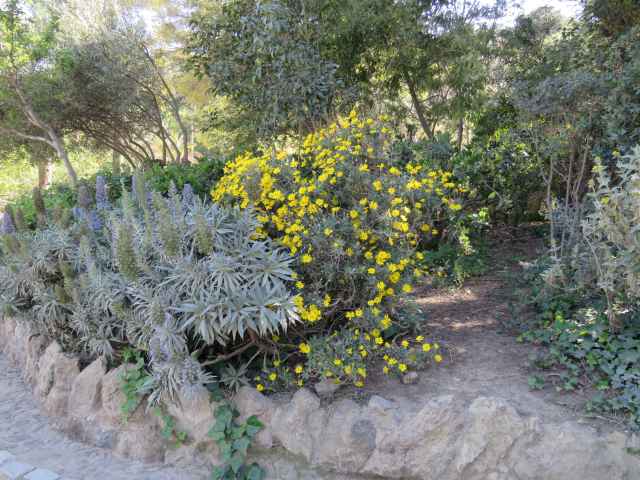
Parc Güell was part of an ambitious suite of work Catalan architect, Antoni Gaudi carried out for entrepreneur, Count Eusebi Güell in the early 1900s. It was originally planned to be a luxury housing development so clearly that is not a modern concept but the housing did not progress and, over time, the park became a green oasis that opened to the public.
Clearly Gaudi enjoyed it because he bought one of the only two houses on the site (not his own work) and made it his home for the last 20 years of his life.

Barcelona is a hot, dry city with a population of over 1.6 million. It is also a city full of trees, particularly plane trees, and streetscapes that prioritise people over motor vehicles. But streetscapes remain that – streets with paved surfaces and spaces shared for many purposes.


Parks are more like breathing spaces, though nowadays it seems that Parc Güell is a space where one will always be sharing the breath of many other people. Regulations allow the admission of 1400 visitors per hour (pre-purchase of tickets is almost always required and days and times can sell out well in advance). While the area landscaped by Gaudi is 12 hectares, there are not a huge number of paths so you would need to get access to the further woodlands to get the feeling of being alone in nature.

It is a park, a UNESCO world heritage site and a major tourist attraction – not a botanic garden. This means that the plantings play something of a second fiddle to the structure Gaudi created and the experience of the visit.

The structures Gaudi created In Parc Güell are described as coming from his *naturalistic* phase, different to his creation of the Sagrada Familia. Personally, I would describe it as a blend of naturalism with Arts and Crafts and a fair lacing of Rococo but others may disagree.

There are a lot of colonnades in Parc Güell and I assume that as well as being an architect and a wildly eccentric creative, Antoni Gaudi was also a very good engineer. Some of the colonnades are supporting considerable weight.

The somewhat over the top, naturalistic looking colonnades designed to have a rough hewn appearance give the broader structure to the park. The focal point of the huge terrace is also supported on a sea of columns but classical in style. From above, it just looks like a piece of land that has been levelled out, unless you look at the side.



From below, you can see the structure and, in true Gaudi style, he has altered the roof of the colonnaded structure below to change the flat form. As a general rule, I am not a great fan of mosaics but the light catching the mother-of-pearl effect was another experience when the beauty of light caught within the structure was simply amazing. Just beautiful.


It is a narrow line between whimsy and kitsch. Gaudi certainly delighted in whimsy and it was one of his defining hallmarks. Are the porter’s lodge buildings in Parc Güell whimsical? Yes, they are but in my opinion they lean towards the cutsie-pie end of the spectrum that is weighted to kitsch.


It was the giant lizard that made me think ‘oh dear’. As I have said, I am not a great fan of mosaic work in many contexts and for me, this crossed a line. It reminded me of this giant green lizard I photographed some years ago in a seaside village just north of here. And when I got to see the gifte shoppe at Casa Batlló the next day, there was an entire table of small models of this giant lizard, amongst a whole lot of other novelty souvenirs that had well and truly immortalised the gifted artist and architect in the most astonishingly naff memorabilia. Not that Gaudi is in any way responsible for tacky memorabilia that is being sold 98 years after his death, but it did show me what a narrow line he was treading with his wit and whimsy, how easily it can tip over to kitsch.





I’ve visited Barcelona only once and my time ran out before I had a chance to explore this park. So thank you for the photos and the virtual experience.
More fabulous photos!
And those mosaics are stunning – prefer the subtle ones.
I guess some of it can be a bit kitschy but makes me smile nevertheless
You are right of course. Anything that makes us smile is good.